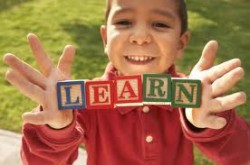Courtesy of Erikson Institute
 Erie is a bilingual charter school predominantly serving Latino students in Chicago’s Humboldt Park neighborhood. The kindergarteners call themselves “children of Loyola,” because every classroom at Erie is named after a different university — a nod to the school’s goal of putting all students on the path to higher education.
Erie is a bilingual charter school predominantly serving Latino students in Chicago’s Humboldt Park neighborhood. The kindergarteners call themselves “children of Loyola,” because every classroom at Erie is named after a different university — a nod to the school’s goal of putting all students on the path to higher education.
“The commitment to graduating college-bound, bilingual, biliterate, and bicultural students is held by everyone, the teachers, the administration, the board,” says Susan Pryor, a kindergarten teacher at Erie. “Everyone is on the same page.”
Erie, which partners with Erikson’s New Schools Project, is a model of bilingual education. However, there is no school system-wide commitment to high-quality biliteracy. Erikson seeks to change this by developing policies, practices, and teacher preparation programs to help meet these students’ unique needs.
DLL Education in Illinois
In Illinois, nearly 8 percent of students are dual language learners (DLL), learning a home language and English simultaneously. The default program for educating them is a transitional bilingual program, which is designed to make non-English-speaking students proficient in English by third grade, when they first take the ISAT, or Illinois Standard Achievement Test. In this approach, the student’s native language is not supported beyond the transitional period. In comparison, Erie offers two program options, both with the goal of educating bilingual children: dual language and general education in English with a daily period of Spanish.
Pryor’s kindergarten class is in the dual language program, an immersive approach in which her students spend 80 percent of their day speaking Spanish. When the students move to second grade, the Spanish to English ratio will go to 70/30, and in fourth grade, 60/40. When they reach fifth grade, the ratio will be 50/50 and remain so for all additional grade levels.
Too few schools match Erie’s commitment to teaching dual language learners, says Luisiana Meléndez, clinical assistant professor and director of Erikson’s online Bilingual/ESL Certificate Program. “There’s a lot of misinformation out there,” she says. “People think that if students don’t learn English by preschool, then they never will. Or they think that it’s too confusing to learn two languages at once.
“The biggest thing teachers and administrators need to understand is the better a child learns his first language, the better he’ll learn his second language.” Children are often rushed into learning English in the classroom, according to Meléndez, and parents are sometimes encouraged by teachers to speak English at home — even when they themselves have a limited command of the language. For the full Dual Language, Dual Learning report, visit www.erikson.edu.












